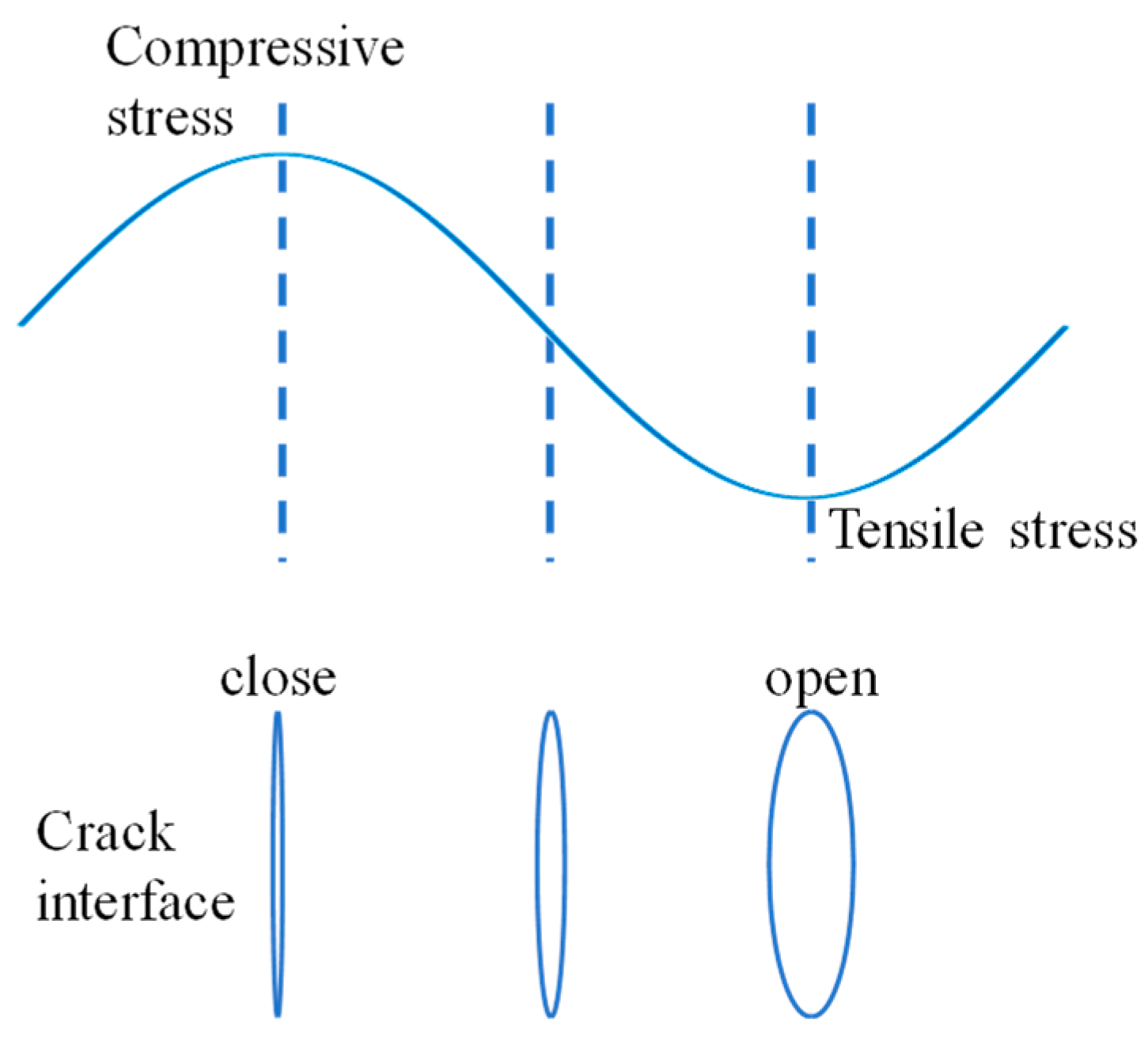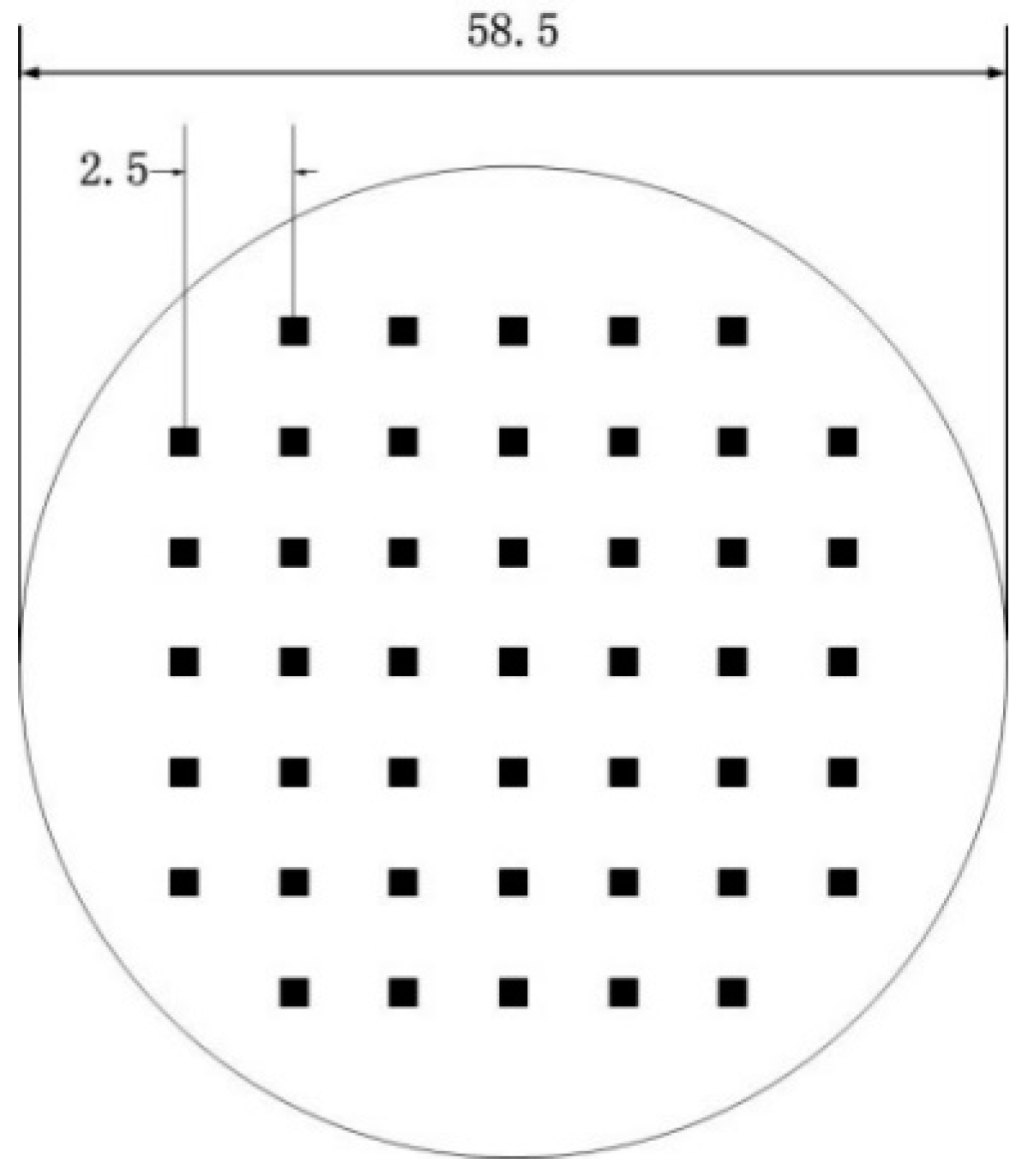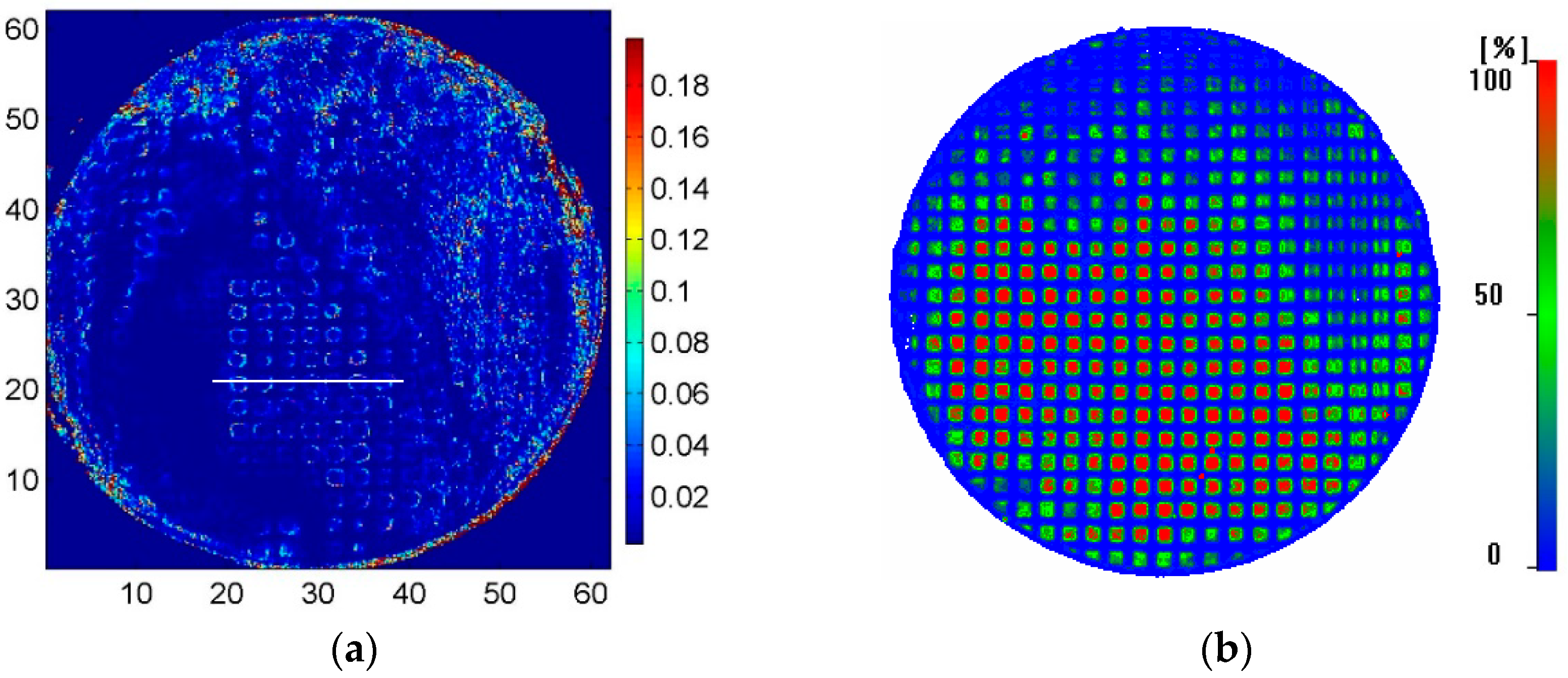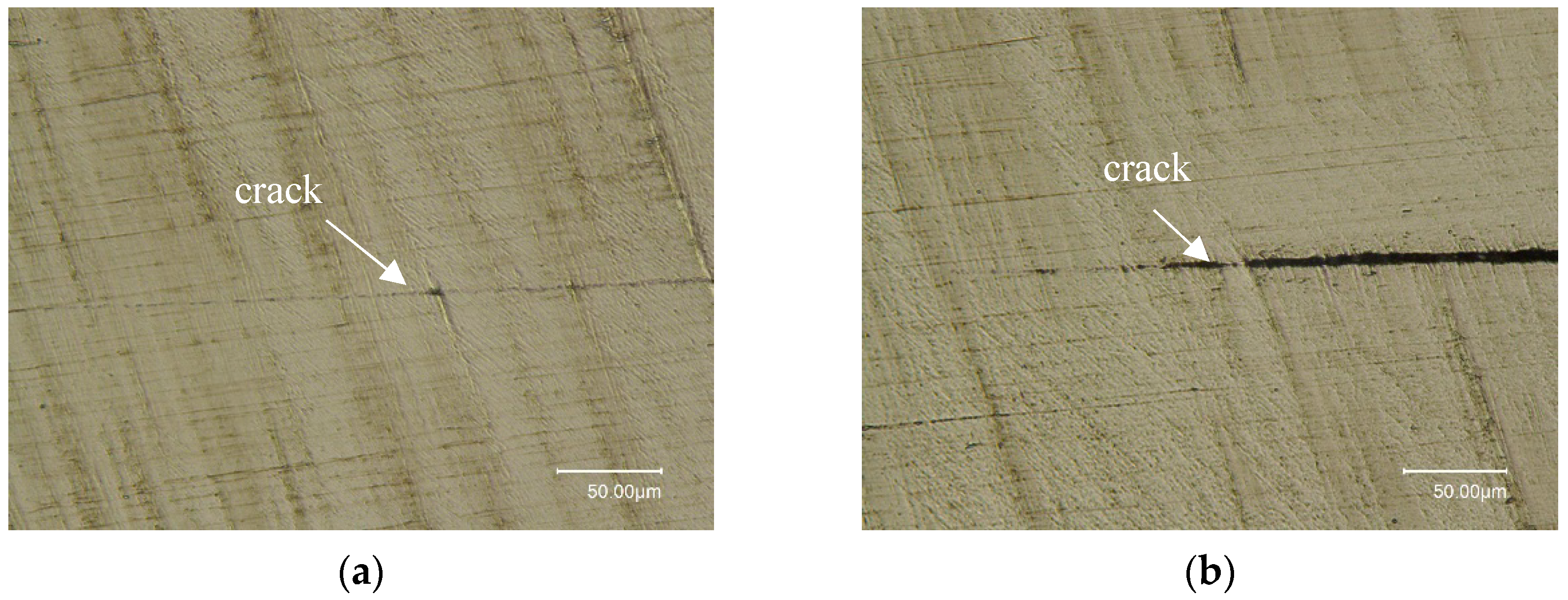1. Introduction
Diffusion bonding (or diffusion welding) is a welding method that applies a certain temperature and pressure to two weldments to make the two surfaces come into contact with each other and maintains them for a certain time in a vacuum or protective atmosphere so that the contact surfaces undergo local microscopic plastic deformation and atomic diffusion to achieve connection [
1,
2]. It has become an indispensable technology in aerospace, power electronics, and other industries used in the manufacturing processes of engine blades and fuselage shells [
3,
4].
However, diffusion bonding has high requirements for welding processes such as temperature and pressure. The surface roughness, cleanliness, and material composition and microstructure of the welding surface can also have a significant impact on the welding process, and defects such as incomplete welding are prone to occur at the weld interface. Of particular note is the contact-type defect that may occur in diffusion-bonded joints, the nature of which has not been clearly studied, and it often represents the lack of welding at the two interfaces. Since the surfaces of the defect are in close contact, conventional ultrasound is almost completely transmitted at the interface, making it difficult to detect [
5]. The lack of accurate detection methods for contact-type defects in diffusion-bonded interface seriously affects the large-scale application of diffusion-bonded structures in important fields such as aerospace, and therefore, a reliable non-destructive testing method is urgently needed to evaluate the quality of diffusion bonding.
Initially, interface resistance measurement was used for the non-destructive testing of diffusion-bonded joints [
6], but it is generally applicable to the detection of larger-sized defects. Considering the similarity between diffusion-bonded joints and brazed or resistance spot welded joints, the ultrasound C-scan method has been used to scan the diffusion-bonded interface and process the obtained images to roughly obtain the interface bonding ratio, so as to optimize the diffusion bonding process [
7], or estimate the mechanical properties (such as impact toughness) of diffusion-bonded joints based on the interface bonding ratio [
8]. However, the longitudinal resolution of the C-scan method is limited by the pulse width of the transmitted signal of the probe. If the detection capability of small defects is to be enhanced, the most direct method is to increase the detection frequency of the probe [
9,
10], but the attenuation of sound waves in the medium also increases sharply, that is, the detection thickness decreases. At the same time, increasing the detection frequency also makes the detection system more complex and increases the detection cost. Another way is to analyze the full waveform of the C-scan to extract waveforms, spectra, phase characteristics, etc. that reflect the performance of the diffusion-bonded interface, that is, using the ultrasonic characteristic scanning method (F-scan) to detect the diffusion-bonded components [
11,
12], thereby further improving their detection capability. However, this method requires complex signal processing, and it still falls within the scope of linear ultrasound, and its detection sensitivity will not exceed 1/2 of the corresponding wavelength.
During the formation of diffusion-bonded joints, if a large number of micro-pores, micro-cracks, and other defects occur at the interface, the mechanical properties of the interface will exhibit high nonlinear characteristics. When the incident sound wave reaches this interface, it will undergo a series of nonlinear interactions with it, and significant nonlinear components may appear in the received signal [
13,
14]. Therefore, people consider using nonlinear acoustic methods to characterize the interface state. This method is theoretically not limited by the detection frequency and has higher detection sensitivity to small defects, especially when contact-type defects exist, and significant nonlinear components will appear in the received signal [
15,
16]. Studies have shown that linear ultrasound is more sensitive to macro-sized defects, and for contact-type defects, the linear ultrasound echo is weak, but the nonlinear response is strong [
17,
18,
19]. However, there are currently few studies on the use of nonlinear ultrasound methods in pulse-echo mode to detect contact-type defects in diffusion-bonded joints. If the nonlinear component can be excited by an ultrasound pulse and extracted from the echo, the nonlinear ultrasonic method can be applied to practical testing. Furthermore, like the linear ultrasonic C-scan method, the nonlinear ultrasonic C-scan image can be obtained.
In this paper, the nonlinear ultrasonic testing in pulse mode is investigated and the nonlinear ultrasonic C-scan imaging is developed. A diffusion bonding sample with artificial cracks on the bond interface is designed and fabricated, a nonlinear ultrasonic C-scan scheme using dual-transducers and the corresponding device are also designed, and then the sample is detected with nonlinear ultrasonic imaging and compared with linear ultrasonic C-scan; finally, the metallography results of the bond joint is used to verify the detection method.
2. Principle of Nonlinear Ultrasonic Testing
The high-order harmonic method in nonlinear acoustic testing methods is used in this paper. Generally, there are two physical mechanisms for generating high-order harmonics: the nonlinear elastic mechanism (nonlinear elasticity), also known as classical nonlinearity, and the contact nonlinearity mechanism, also known as non-classical nonlinearity [
20].
Classical nonlinearity theory is generally used to explain material nonlinear phenomena caused by plastic deformation, fatigue damage, etc. It believes that the stress–strain (
σ-ε) relationship in the material damage area shows a nonlinear relationship, that is,
where
E is Young’s modulus;
γ is the second-order nonlinear elastic coefficient, also known as the nonlinear parameter.
Thus, the nonlinear wave equation can be obtained (only one-dimensional situation is given in this paper, taking the first-order approximation)
where
ρ is the density of the medium;
u is the displacement of the mass point;
t is the propagation time;
x is the propagation distance.
Under the conditions of constant wave number
k and propagation distance
x, if the amplitude values
A1 and
A2 of the fundamental wave and the second harmonic signal at a specific position are known, the formula for calculating the nonlinear parameter can be obtained as follows:
According to the measured nonlinear parameters, the degree of material damage can be characterized.
However, when cracks and other contact defects appear in the structure, their acoustic nonlinearity will increase sharply, and the nonlinear parameter
γ value measured at this time will be much larger than before the appearance of the crack. Its mechanism can be represented phenomenologically by
Figure 1. When the ultrasonic wave is evident on the contact defect interface, the two contact surfaces produce relative motion under the action of the ultrasound. In a complete vibration cycle, the ultrasonic wave generates compressive stress and tensile stress on the interface, and the interface closes and opens under its action; in the closed state, it is equivalent to an intact interface, and the ultrasound passes through almost completely, whereas in the open state, it is equivalent to the interface between the medium and air, and the sound wave is almost completely reflected at this interface. That is, only half a cycle of the sound wave can transmit through or reflect from the interface and then be received. Therefore, the higher harmonic components are present in the received signal, and the nonlinear parameter can be calculated from the received signal.
According to the above theory, the nonlinear detection method is more sensitive to small defects, especially the contact-type defects in diffusion-bonded or adhesive-bonded joints than the linear methods.
4. Results
According to the calculation results in 3.4, the probe spacing and focusing positions were adjusted, and typical received echoes at the diffusion bonding specimen interface were obtained, as shown in
Figure 5. The arrows in the figure indicate the surface reflection echoes of the specimen, the diffusion bonding interface reflection echoes, and the bottom reflection echoes of the specimen.
From
Figure 5, it can be seen that under the conditions of oblique incident reception by dual probes, there are strong reflection echoes at the defect interface. The receiving probe used in the experiment has a center frequency of 20 MHz. Theoretically, the received signal only contains the 20 MHz signal and its nearby frequencies. However, in actual detection, due to the strong excitation signal, weak harmonic signals may be received even though the center frequency of the receiving probe is 20 MHz, which masks the weak second harmonic component. Therefore, to obtain the nonlinear testing result, it is necessary to calculate the nonlinear parameter
γ based on the scanning signal and then regenerate the image corresponding to the detection position. Since the C-scan system used in the experiment does not have the function of harmonic extraction, the extraction program in 3.4 is used to complete the above signal processing and image generation process. That is, the interface waveform at each detection point is separately extracted and transformed into the frequency domain, and the amplitudes of the fundamental wave and the second harmonic are measured separately, so as to calculate the nonlinear parameter of this point interface. The obtained nonlinear C-scan imaging results are shown in
Figure 6a, where the brighter the color level, the higher the value of the nonlinear parameter. It can be observed that the lower part of the specimen shows low nonlinear parameters, while the upper and right parts show high nonlinear parameter values. The central region of the detection image appears as a hollow square, indicating that the central region of the square has a low nonlinear coefficient, while the edge region has a high nonlinear coefficient. According to the nonlinear detection principle, it is inferred that there are a large number of contact-type defects in the upper and right parts of the specimen, the central region of the artificial defect in the central region of the specimen is completely unbonded, and there is contact between the upper and lower interfaces in the edge region, forming a contact-type defect. Under the action of sound waves, the contact-type defect region will undergo opening and closing movements, thereby changing the waveform of the reflected sound wave; that is, the current detection point has a high nonlinear parameter value, which is reflected in the detection image as a high color level.
For comparison,
Figure 6b shows the results of conventional linear ultrasound C-scanning, using a single probe in pulse-echo mode. The probe used is the B probe specified in
Table 2, with a center frequency of 20 MHz. The probe is adjusted to focus the sound beam at the interface of the specimen. From the image, it can be observed that the upper and right parts of the specimen show irregular shape arrays with lower gray levels, while the middle, left, and lower parts display regular square dot arrays with higher gray levels in the central region and lower gray levels in the surrounding areas. This indicates that the artificial defects in the upper and left parts have poorer fabrication quality, with possible partial contact between the upper and lower interfaces of the defects, resulting in lower sound reflection coefficients. On the other hand, the artificial defects in the middle, left, and lower parts have better fabrication quality, with their positions and shapes matching the expected ones. This may be due to uneven pressure during the welding process. The sound waves are almost entirely reflected back without penetrating through the defects.
It can also be noticed in
Figure 6b that for the C-scan results of most square defects, the grey levels in the middle part are higher than those of the edges. This indicates that there is some contact at the edges of the defects in the middle part, resulting in lower sound reflection coefficients at the edges. It is speculated that this is due to the larger size of the square defects fabricated artificially, with the largest gap in the center and smaller gaps towards the edges, until complete contact and fusion. According to the principles of nonlinear ultrasound testing, this technique is more sensitive to small defects and defects with close contact, where the amplitude of the second harmonic at the intact region between the defect center and the defect should be lower, while the amplitude at the defect edge should be higher.
By comparing the nonlinear and linear detection results shown in
Figure 6a,b, it can be observed that they complement each other well. For the well-welded samples and samples with large defect gaps in the left part, both nonlinear detection results show low echo signals, while the conventional linear ultrasound can detect regularly arranged artificial defects. For the upper and right parts of the samples, the nonlinear detection results show high echo signals, while the conventional linear ultrasound detection shows smaller echo amplitudes. Especially in the middle region, the nonlinear ultrasound detection shows a hollow square, while the linear ultrasound detection results show a high echo reflection coefficient at the center of the square. Therefore, in practical detection, the results of both methods should be combined to make a reasonable judgment on the quality of the detection area.
To further study the relationship between the nonlinear scan and linear ultrasound scan detection results, the grayscale distribution at the same position in the middle region (indicated by the white line in
Figure 6a) was obtained and compared, as shown in
Figure 7. It can be observed that the areas with higher nonlinear parameters are mostly located at the edges of defects detected by linear ultrasound, indicating the presence of contact-type defects with strong nonlinear effects in this area, while the center region of the defects has relatively lower nonlinear parameters, which is consistent with the principle of nonlinear detection. The nonlinear parameter (γ) values in the edge area (~0.003) of the defects are on average 10 times (20 dB) higher than that in the center (~0.03) of the defects.
To validate the above analysis, the sample is dissected with a wire-electrode cutting process; the cross-section is perpendicular to the bond interface and traverses a row of artificial cracks. The cross-section plane was ground with sandpaper from coarse type to fine type and then polished with polishing cloth and suspension.
Figure 8 shows the dissected results of the defects in the right and middle parts of the sample. It can be observed that the defects in the right part fit tightly, while the defects in the middle part have obvious gaps (about 5 μm), but the gaps become smaller as they approach the edges, and even complete contact and fusion can be seen.
5. Discussion
Next, the above results are compared with traditional ultrasonic C-scan results of diffusion bonds and nonlinear ultrasonic testing using tone burst wave excitation. According to the detection theory, when there is a large gap, the linear ultrasound reflection coefficient is high, while the nonlinear parameter is low. Contact-type defects have high nonlinear parameters and low linear sound wave reflection coefficients. The dissected results indicate that the nonlinear parameter imaging results in this study are consistent with the theoretical expectations. In Ref [
11], according to the principle of acoustic echo phase change on the crack interface, the researchers proposed a new algorithm using both amplitude and phase characteristics of the echo on the bond interface. The unbond defect and kissing bond (contact-type defect) in the diffusion bond joint have been detected by the method. However, it requires extracting both amplitude and phasing characteristics during detection. For most nonlinear ultrasonic methods, including that in Ref [
15,
16,
17,
18,
19], the excitation signal is a tone burst wave, which makes it difficult to extract the echo on the bond interface. Compared with the previous methods, the nonlinear ultrasonic C-scan imaging proposed in this work can easily obtain the echo on the bond interface and only needs simple signal processing to extract the nonlinear parameter and to form the C-can image. Over and above, the nonlinear ultrasound detection method has a high sensitivity to contact-type defects in diffusion-welded joint interfaces. By using nonlinear parameter imaging for C-scan detection of diffusion-welded samples, it can effectively complement the deficiencies of linear ultrasound methods in detecting such defects. It is suggested that both methods be combined to achieve a more accurate evaluation of the quality of diffusion-welded joints.
6. Conclusions
In this study, the dual-probe nonlinear ultrasound C-scan method in pulse mode is proposed and its effectiveness in detecting contact-type defects is verified. A device is designed and fabricated for pulse wave excitation and reception. The results demonstrate that the contact-type defects in the titanium alloy diffusion-welded joints exhibit strong nonlinear effects. The nonlinear parameter on the bond interface is determined by extracting the fundamental and second harmonic wave from the interface echo, and the results demonstrate that the amplitude of the nonlinear parameter on the contact-type defects is about 10 times higher than that of the macro-cracks. The nonlinear ultrasonic C-scan image is achieved based on nonlinear parameters, and the result indicates that it can provide a powerful complement to linear ultrasound detection.
According to the results, it is suggested that the combination of the two methods is expected to achieve an accurate evaluation of the quality of diffusion-welded joints. In this work, the dual-probe mode was used due to the lack of a broad bandwidth transducer. In the future, the transducer with broad bandwidth can be developed to excite a pulse wave and receive the second harmonic of the echo, and then the nonlinear ultrasonic imaging can be more widely applied to the field test.













